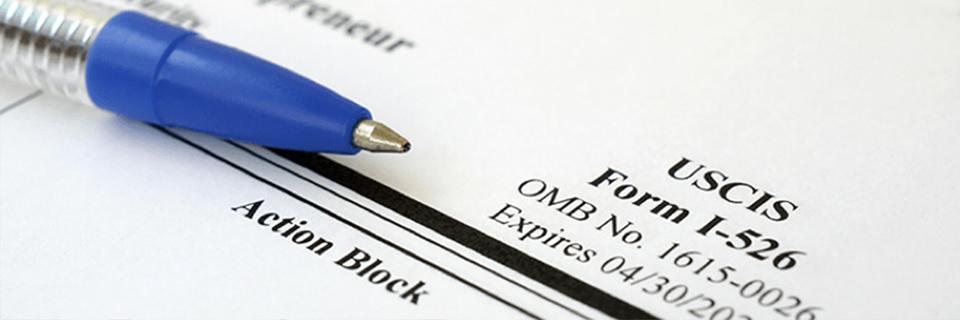
When pursuing a U.S. Green Card through the EB-5 Immigrant Investor Program, it is important to have a full understanding of the program’s timeline. This is critical for investors because it can have major implications for their families’ relocation plans. However, predicting a precise timeline can be difficult.
This article will outline the various steps in the EB-5 visa process, how long each stage typically takes, the factors that can lead to delays, and the actions investors can take to speed up the process.
A Step-by-Step Guide to Applying for the EB-5 Visa Program
- 1. Invest in a New Commercial Enterprise (NCE)
- 2. Submit Form I-526/I-526E to USCIS
- 3. Apply for a Conditional Green Card
- 4. Fulfill All EB-5 Program Requirements
- 5. Submit Form I-829 to USCIS
The Main Factors That Impact an Investor’s EB-5 Visa Timeline
How EB-5 Visa Wait Times Are Determined
Tips for Speeding up the EB-5 Timeline
- 1. Invest in a Targeted Employment Area (TEA)
- 2. Invest Through a Regional Center
- 3. Complete All Forms as Fully and Accurately as Possible
Start the Process with EB5AN
A Step-by-Step Guide to Applying for the EB-5 Visa Program

The goal of the EB-5 visa program is to drive economic growth in the United States by attracting foreign investment as a way to create jobs for U.S. workers. Foreign investors are able to live and work in the United States during the process, and eventually establish permanent resident status—often referred to as a U.S. Green Card. The program also allows the investor’s spouse and any unmarried children under 21 to obtain Green Cards.
There are several key steps in the EB-5 visa program, including:
1. Invest in a New Commercial Enterprise (NCE)
EB-5 program applicants first need to invest in a new commercial enterprise (NCE) or in a troubled business that they will restructure or expand. If the chosen NCE is based in a targeted employment area (TEA)—an area with a population of fewer than 20,000 people or an unemployment rate at least 150% of the national average—then they only need to invest $800,000. Otherwise, they must invest $1,050,000.
EB-5 applicants can make their investments either directly or through a regional center. A direct investment is when the individual invests capital directly into the NCE. In this scenario, the EB-5 investor is usually involved in the day-to-day management of the business. However, the vast majority of EB-5 investors choose to use a regional center, which is an organization set up to combine EB-5 funding from several investors to manage the allocation of the funds.
2. Submit Form I-526/I-526E to USCIS
After making their investment, individuals must apply for the EB-5 program by submitting Form I-526/I-526E to the United States Citizenship and Immigration Services (USCIS). If they made their investment through a regional center, then they must submit Form I-526E, Immigrant Petition by Regional Center Investor.
3. Apply for a Conditional Green Card
Once USCIS has approved an investor’s I-526/I-526E petition, they are eligible to apply for a conditional Green Card. For individuals already living in the United States, this means submitting Form I-485, Application to Register Permanent Residence or Adjust Status. Under the EB-5 Reform and Integrity Act of 2022 (RIA), eligible foreign nationals on non-immigrant visas can file their Form I-485 concurrently with their I-526E.
Those living outside of the United States are required to submit Form DS-260, and usually attend a visa interview at the U.S. embassy or consulate in their home country. Once approved, the EB-5 program applicant’s conditional Green Card is valid for two years, allowing them and their family members to live and work in the United States.
4. Fulfill All EB-5 Program Requirements
After obtaining a conditional Green Card, the investor must fulfill all EB-5 program requirements over the following two years. This means that they must maintain their investment in their NCE and create 10 full-time jobs for U.S. workers. Direct investors can only count direct jobs toward the EB-5 program’s job creation requirement, whereas regional center investors may count both direct and indirect jobs, as well as induced jobs.
Indirect jobs are those jobs that are created as a result of the NCE’s economic activity. Induced jobs are those jobs that are created in the local community as a result of increased economic activity from the NCE. Economic models are used to calculate these indirect and induced jobs.
5. Submit Form I-829 to USCIS
In the last 90 days before the end of the investor’s two-year conditional Green Card period, they are required to submit Form I-829 to USCIS to demonstrate that they have met all of the EB-5 visa program’s requirements. After it is approved, the investor, their spouse, and their eligible dependents are granted permanent resident status, and receive their U.S. Green Cards.
The Main Factors That Impact an Investor’s EB-5 Visa Timeline

There are several factors that can play a role in how long it takes to go through the full EB-5 visa program. USCIS provides estimated processing times, but the wait times for the EB-5 visa process can be very difficult to predict. Some EB-5 investors will be able to secure their conditional Green Card much more quickly than the estimated wait time provided by USCIS, while others may have to wait much longer.
The most important factor that impacts an EB-5 investor’s wait time is the number of Form I-526Es submitted from the investor’s home country. If a large number of people submit Form I-526Es to USCIS from a particular country, it will lead to backlogs and longer wait times due to limited EB-5 immigrant visa quotas for each country.
Like many of the factors that affect the timeline, visa backlogs from a particular country are outside any individual EB-5 investor’s control. However, there are some actions that investors can take to help speed up their EB-5 visa timeline so they can obtain their permanent Green Card more quickly.
How EB-5 Visa Wait Times Are Determined

When USCIS receives an investor’s Form I-526E, it gives them a “priority date” that tells when the form was received. This date is important for determining when the investor will be allocated an EB-5 visa. Although EB-5 investors can file their I-526E at any time, they are processed based on visa availability.
Only a certain number of EB-5 visas are issued each year. Historically, only 10,000 EB-5 visas are available each immigration fiscal year, which runs from October 1 to September 30. However, this number includes the EB-5 visas for the applicant as well as their spouse and dependents.
To make the distribution of EB-5 visas from different countries as equitable as possible, there is also a per-country limit on available EB-5 visas. The overall demand for EB-5 visas can vary dramatically from one country to the next, so wait times can also vary depending on an applicant’s home country.
If the quota for a given year has already been reached, then the EB-5 program applicant will have to wait at least one year for their Form I-526E to be processed, which is known as “visa retrogression.” The more EB-5 visa applications there are from a backlogged country, the longer the newest applicants will need to wait for their Form I-526E to be processed by USCIS. If demand is very high, applicants from backlogged countries, such as China, may have to wait for several years for an EB-5 visa.
The Best Way to Estimate EB-5 Visa Processing Times
The most up-to-date estimated EB-5 visa processing times can be found on the USCIS website. These wait times are based on the amount of time it takes USCIS to process 80% of all the applications it receives. So, the vast majority of applications will be processed more quickly than this estimated time that USCIS provides, while only 20% will take longer.
For example, if the estimated processing time for Form I-526E is 55.5 months, 80% of all forms will be processed more quickly by USCIS. Based on experience, many applications are processed within 12 months. Still, USCIS does not give any information on the longest or the shortest EB-5 visa wait times.
To be safe, it is always best to assume that an application will take at least as long as the estimated processing time. Otherwise, the EB-5 applicant and their family may be unprepared in case of a delay.
Tips for Speeding up the EB-5 Timeline

There are some steps that immigrant investors can take to potentially reduce their EB-5 visa wait time. These include:
1. Invest in a Targeted Employment Area (TEA)
As noted earlier, a TEA is an area with a population of fewer than 20,000 people and an unemployment rate at least 150% of the national average. Investments in rural TEAs not only qualify for the reduced $800,000 investment amount, but also roughly a third of set-aside EB-5 visas as well as priority processing of Form I-526E. Because of the risk of visa backlogs and the importance of Form I-526E processing times in the overall timeline, investing in a TEA could potentially speed up the process of obtaining a U.S. Green Card through the EB-5 program.
2. Invest Through a Regional Center
As explained earlier, regional centers are designated by USCIS to pool and manage EB-5 investors’ funds. Regional centers can submit exemplar Form I-526Es for their projects to USCIS. Once approved, all future Form I-526Es for that particular project will automatically be approved except for the portions related to the individual’s personal information. This can accelerate the time it takes USCIS to process the Form I-526E.
3. Complete All Forms as Fully and Accurately as Possible
One of the factors that EB-5 investors have the most control over is the completeness of the information they submit to USCIS. Failure to complete all USCIS forms properly or to provide the documentation requested can slow down the processing of the application.
If USCIS does not believe that it has enough information to approve a form, it could issue a request for evidence (RFE). In these cases, the EB-5 investor needs to send additional information before the process can continue. USCIS may also issue a notice of intention to deny (NOID). In these cases, EB-5 investors must provide a detailed response citing why the NOID is incorrect and cite the laws and documentation to prove it.
To avoid these scenarios, it is always best to seek professional guidance from EB-5 program experts and an immigration attorney when completing all forms to be submitted to USCIS.
Start the Process with EB5AN

While it can be difficult to predict the EB-5 program timeline, having a clear sense of the steps in the process and the factors that can make it either shorter or longer is important.
EB5AN has helped more than 2,300 families from 60 countries relocate to the United States as lawful permanent residents. Our expert team has more than a decade of experience, and offers clients first-rate, low-risk EB-5 regional center projects with 100% USCIS project approval rate to date.
To begin your family’s journey toward becoming U.S. Green Card holders, schedule a free meeting with EB5AN today.










